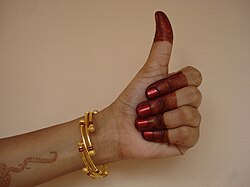| # | Name in Sanskrit | Translation(s) in English | Other meanings and usage | Illustration |
|---|
| 1. | Pataka | flag | beginning a dance, forest, river, sprinkling water, cloud, night, forbidding things, horse [2] |  |
| 2. | Tripataka | three parts of the flag | tree, arrow, vajra weapon, Indra, crown, light rising, union [2] |  |
| 3. | Ardhapataka [3] | half flag | flag, temple tower, horn, riverbank, tender shoots, writing panel, knife [2] |  |
| 4. | Kartarimukha | scissors face or arrow shaft face | separation of women and men, opposition, stealing, corner of the eye, death, disagreement, lightning [2] |  |
| 5. | Mayura | peacock or peacock's beak | bird of omen, forehead, stroking the hair, wiping tears, argument [2] |  |
| 6. | Ardhachandra | half moon | spear, platter, anxiety, meditation, prayer, greeting [2] |  |
| 7. | Arala | bent | drinking poison [2] |  |
| 8. | Shukatunda | parrot head | shooting an arrow, throwing a spear, mystery [2] |  |
| 9. | Mushthi | closed fist | steadiness, holding things, grasping the hair, wrestling [2] |  |
| 10. | Shikhara | mountain top or spire | God of Love, bow, pillar, sound of a bell, silence, questioning, husband, lover, embrace [2] |  |
| 11. | Kapitta | wood apple | Goddess Lakshmi, Saraswati, holding cymbals, holding flowers at the time of flirting, milking cows [2] |  |
| 12. | Katakamukha | opening of a bracelet | picking flowers, holding a pearl necklace or garland of flowers, drawing a bow slowly, speech, glancing [2] |  |
| 13. | Suchi | needle | Parabrahma, one, one hundred, sun, city, world, fan, threatening, astonishment, umbrella, beating the drum [2] |  |
| 14. | Chandrakala | crescent moon | digit of the moon [2] |  |
| 15. | Padmakosha | lotus bud | water lily, fruit, apple, mango, breast [2] |  |
| 16. | Sarpashirsha | snake head | giving water to Gods and sages, the flapping of elephant's ears, slowness [2] |  |
| 17. | Mrigashirsha | deer head | women, calling the beloved, cheek, holding an umbrella, actor's costume, house, fear, discussion [2] |  |
| 18. | Simhamukha | lion face | elephant, lotus, coral, pearl, garland, fragrance, drop of water, salvation when placed on the heart [2] |  |
| 19. | Kangulashya | tail | Lakuce fruit, water lily, breast [2] |  |
| 20. | Alapadma or Solapadma | lotus in full bloom | yearning for the beloved, mirror, moon pavilion, full moon, village, murmuring sound, praise [2] |  |
| 21. | Chatura | square | eyes, musk, a little, breaking to pieces [2] |  |
| 22. | Bhramara | bee | parrot, crane, cuckoo, union [2] |  |
| 23. | Hamsasya | swan beak | tying the marriage thread, initiation, painting, drop of water [2] |  |
| 24. | Hamsapaksha | swan wing | arranging, constructing a bridge, making marks with the nails, number six [2] |  |
| 25. | Sandamsha | Padmakosha mudra repeatedly opened and closed | generosity, worship, offering, number five [2] |  |
| 26. | Mukula | flower bud | water lily, the God of love, eating [2] |  |
| 27. | Tamrachuda | rooster | crane, camel, calf, writing or drawing [2] |  |
| 28. | Trishula | trident | three together, wood apple leaf [2] |  |







































